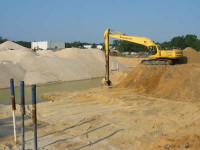Steven N. Chillrud, PhD
Arsenic mobilization at anthropogenically impacted sites
Vineland Superfund Site

The Vineland Chemical Company located in southern NJ improperly stored and disposed of their arsenic chemicals for several decades as a biocide manufacturing facility. This led to extensive arsenic contamination of subsurface soils and groundwater in addition to offsite arsenic transport. At the Vineland Superfund Site, a large pump and treat remediation facility (~ 2 million gallons/day) began operation in 2000, and has significantly reduced offsite arsenic transport. It also led to an initial decrease in groundwater total arsenic concentrations in the pumping wells by as much as 10x. Several more years of pump and treat as well as remediation efforts focused on excavation, cleaning, and replacing contaminated vadose zone soils has led to only relatively minor additional improvements in groundwater arsenic levels, which can still have more than 1000 ppb As, depending on the well. The aquifer sediments are still elevated in arsenic and represent a reservoir of arsenic at the Vineland site, causing continued groundwater contamination.
Our work is laying the groundwork for testing the hypothesis that the time frame for remediating arsenic contaminated aquifers via pump and treat could be substantially reduced by subsurface additions of chemical amendments. The goal is to increase the mobilization of arsenic from aquifer solids and therefore increase the amount of arsenic being removed from the aquifer with each volume of water pumped out of the ground and treated. To date, we have primarily focused on laboratory experiments designed to evaluate the efficacy of chemical amendments for mobilizing arsenic from aquifer solids. The most promising chemical amendments have been sodium phosphate and oxalic acid. We are now planning in situ field experiments using subsurface chemical amendments to build on these laboratory results. Modeling groundwater flow and transport at the site has helped design optimal locations for injection and monitoring wells within the cone of depression of a site recovery well.
We also plan to investigate several basic science questions directed towards both the mechanisms by which the oxalic acid mobilizes arsenic as well as the eventual rates of microbial degradation and sorption of oxalic acid.
For more information, visit the NIEHS Superfund Basic Research Program core description at http://superfund.ciesin.columbia.edu/.
Arsenic and old landfills
Earlier research of our group at the Winthrop Superfund Site in southern Maine suggested that arsenic can mobilized into groundwater by the interaction of highly reducing landfill leachate with underlying sediment found below the landfill. We have followed up investigating the potential of old unlined landfills to be mobilizing arsenic with staff from Region 3 of the NYS Department of Environmental Conservation, including shared field and laboratory efforts on samples collected at several old landfills. A primary goal of this collaboration is to develop an inexpensive triage method for assessing whether an old landfill site has arsenic mobilization issues worth further investigation. The impetus for developing such a method is that new housing developments which can rely on installing private wells for drinking water are becoming more and more common near old landfills. The Lower Hudson Valley has approximately 200 closed, unlined landfills, 3/4's of which were closed prior to 1985 and thus have no monitoring wells.
Related Publications
- Keimowitz, A.R., Y. Zheng, S.N. Chillrud, B.J. Mailloux, H.B. Jung, M. Stute, H.J. Simpson. (2005) Arsenic redistribution between sediments and water near a highly contaminated source. Environmental Science and Technology, 39: 8606-8613.
- Keimowitz, A.R., S. Datta, H.J. Simpson, S.N. Chillrud, M. Stute, M. Tsang, J. Ross, (2005). Naturally-occurring arsenic: mobilization at a landfill in Maine and implications for remediation. Applied Geochemistry 20: 1985-2002.
- Keimowitz, A. R., H. J. Simpson, S. N. Chillrud, M. Stute, M. Tsang, S. Datta and J. Ross (2005). Oxidation of groundwater arsenic and iron. In: Advances in Arsenic Research: Integration of Experimental and Observational Studies and Implications for Mitigation. ACS Symposium Series, vol. 915: 206-219. P. A. O'Day, D. Vlassopoulos, D. Meng and L. G. Benning, Eds. American Chemical Society: Washington, DC.
- Keimowitz, A.R., B. J. Mailloux, P. Cole, M. Stute, H. J. Simpson, S.N. Chillrud (2007) Laboratory investigations of sulfate reduction as a groundwater arsenic remediation strategy. Environ. Sci. Tech., 41(19); 6718-6724.